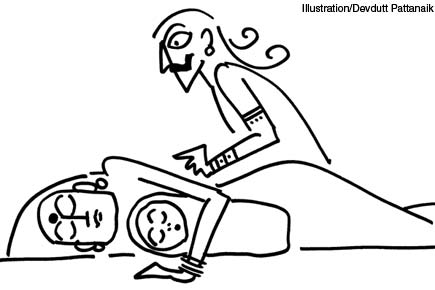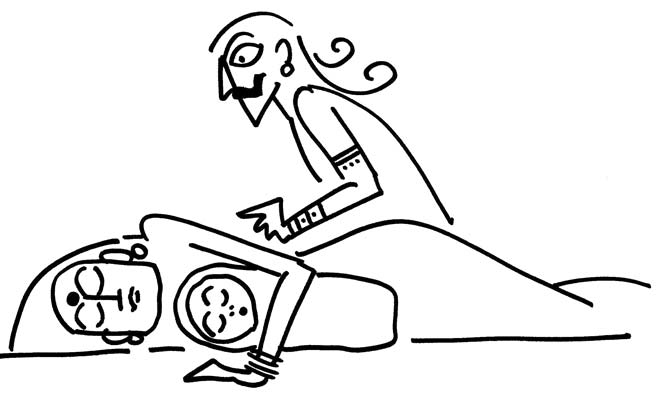The Buddha as we know him today is a creation of European scholars of the 19th century who wanted to make him historical (hence, a creature of the past) and not mythology (an idea that is timeless)


Illustration/Devdutt Pattanaik
 The Buddha as we know him today is a creation of European scholars of the 19th century who wanted to make him historical (hence, a creature of the past) and not mythology (an idea that is timeless). This is because in the 19th century, history was seen as real and mythology false. This outdated idea still plagues Hindu supremacists who want to prove Hindu gods are historical creatures, and not timeless ideas.
The Buddha as we know him today is a creation of European scholars of the 19th century who wanted to make him historical (hence, a creature of the past) and not mythology (an idea that is timeless). This is because in the 19th century, history was seen as real and mythology false. This outdated idea still plagues Hindu supremacists who want to prove Hindu gods are historical creatures, and not timeless ideas.
ADVERTISEMENT
We have been taught that ‘original’ Buddhism was the Theravada school, followed by the Mahayana school of the Bodhisattva, then the Tantrik Vajrayana school of the Buddhist goddesses. Is this true? Or simply an assumption, as there is a vast gap of centuries between when Buddha lived and when we have epigraphic indicators and written documents of Buddhist beliefs.
Buddha lived 2,500 years ago, and the first records of his existence come from Ashokan edicts in Brahmi script. But, which Buddha did Ashoka adore — the historical Buddha, or the mythic Buddha, or a Bodhisattva with his Taras?
The earliest Pali texts of Theravada (Tripatika, Milinda Panha) and the earliest Sanskrit texts of Mahayana (Sadharma-pundarika, Sukhavati-sutra) appear in the same period, approximately around 2000 years ago? How can we be so sure, what came first? Is it our prejudice that rational historical Buddhism, by which we mean Theravada, is oldest, and irrational mythic Buddhism, by which we mean Mahayana, is later? Could it not be the opposite?
Could all three schools have emerged simultaneously in different communities, with the Theravadins favouring Pali language and the intellectual way, the Mahayanis favouring Sanskrit language and the more emotional way of obeisance, and the Vajrayanis preferring ritual and occult and the Goddess? Or, do these three schools represent three phases of Buddhist thought over 1,500 years in different geographies: Theravada in Sri Lanka, Mahayana in Fast East and Central Asia, and Vajrayana in the Himalayan kingdoms?
The Mahayanis looked down on Theravadins and called them Hinayanis, followers of the lower path. Could it be because Theravadins preferred writing in Pali while Mahayanis preferred Sanskrit? Could it because Theravadis adored the teacher, Sakyamuni, and believed in a single historical Buddha, while Mahayanis spoke of the world as full of Buddhas and that every human being is essentially Buddha, essentially awaiting rediscovery [not making sense]? Or, could it be because the Theravadis did not value women, and queer people much, which is why the Buddha of the Theravadis is very masculine, and lacks the feminine grace of the Bodhisattva or the worship of the various Buddhist goddesses?
The Theravadis believed that Buddha’s ideas (sutras) and rules (vinaya) were compiled and transmitted orally in the lifetime of the Buddha. The Mahayanis believe that the doctrines of Buddha were held secretly in the naga kingdom for five hundred years before being revealed to humans. The former doctrine spread to Sri Lanka and thence to Burma. The latter doctrine spread to China and Central Asia via Nalanda in the East and Taxila in the West. Buddhist paintings tell stories of the Jatakas and the Bodhisattvas indicating the popularity of the mythic Buddha amongst the masses. Time for us to reassess our understanding of Buddhism and how contemporary politics, and personal prejudices of scholars, filters our understanding of the past.
The author writes and lectures on the relevance of mythology in modern times. Reach him at devdutt@devdutt.com
 Subscribe today by clicking the link and stay updated with the latest news!" Click here!
Subscribe today by clicking the link and stay updated with the latest news!" Click here!







